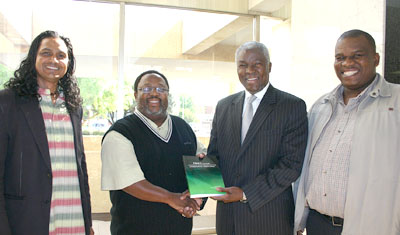 |
At the third Education for Social Justice Research Colloquium the publication Praxis towards sustainable empowering learning environments in South were handed to Prof. Ezekiel Moraka, Vice-Rector: External Relations at the UFS. At this occasion were, from the left: Prof. Dennis Francis, Dean of the UFS Faculty of Education; Prof. Sechaba Mahlomaholo, Research Professor in the Faculty of Education Sciences at the North-West University; Prof. Moraka; and Dr Milton Nkoane, Senior Lecturer in the UFS Faculty of Education.
Photo: Leonie Bolleurs |
This year, the University of the Free State (UFS) was the host for the Research Colloquium: Education for Social Justice for the very first time. It is the third time that this colloquium has been presented.
Prof. Ezekiel Moraka, Vice-Rector: External Relations at the UFS, opened the colloquium, stating that academics, through their research, are ultimately in a good standing to advise government on important issues such as social justice for them to address these issues accordingly.
Prof. Sechaba Mahlomaholo, Research Professor in the Faculty of Education Sciences at the North-West University, delivered the opening address on the theme: Validating community cultural wealth towards sustainable empowering learning environments for social justice. He said that the legacy of our recent past as South Africa still continues to haunt us, especially as exemplified in the dysfunctionalities that are rife in our education.
“With the colloquium we manage to bring together the ideas, thoughts, resources and efforts of educators and/or educationists concerned with the creation of a more equitable, equal, free, hopeful, peaceful and socially just society. Through our teaching, our community engagement and research activities we strive towards a more humane, caring, respecting and respectful South Africa and the world,” he said.
According to Prof. Mahlomaholo, education and its research are some of the most potent mechanisms at the very centre of social transformation. The papers at the colloquium focused on investigating, understanding and responding to issues of amongst others:
- The medium of teaching and learning which continues to be a barrier to many learners to perform to the best of their abilities in the majority of the education institutions in South Africa;
- Health, sexuality, HIV/Aids, stigmatisation and other deseases plaguing our communities currently;
- Self-fulfilling prophecies and stereotypes about some learners not being as intelligent as the rest and this finally being reflected and confirmed in their poor academic achievements;
- Differentiated levels of parental involvement in the activities of their children’s learning due to long absences from their families as they have to work in far-off places of employment;
Papers delivered at the colloquium moved beyond merely identifying the problems; they also suggested possible and plausible research-based solutions to these, such as integrating HIV/Aids education in curricula, listening to the aspirations of significant stakeholders such as mothers and parents generally in teaching and facilitating more rigorous community engagement practices.
At the colloquium gala dinner the book Praxis towards sustainable empowering learning environments in South Africa by authors Dr Milton Nkoane, Senior Lecturer in the UFS Faculty of Education, Prof. Mahlomaholo and Prof. Dennis Francis, Dean of the Faculty of Education at the UFS, was launched. The publication consists of a collection of the best peer-reviewed papers from a conference with the theme Creating sustainable empowering learning environments through scholarship of engagement. The main criterion for inclusion was that the paper should contribute to the theme by means of an original, tight, theoretical and empirical study conducted with the aim of informing the practice of creating sustainable empowering learning environments. The concrete cases examined in many of the chapters are very useful to helping readers understand the specific, on-the-ground concerns related to higher education and schools.
Media Release
Issued by: Leonie Bolleurs
Strategic Communication
Tel: 051 401 2707
Sel: 0836455853
Email: bolleursl@ufs.ac.za
30 September 2010